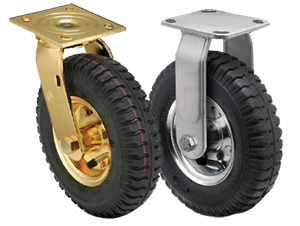
Casters are often categorized according to the material from which their wheels are made. Some of them feature neoprene wheels, whereas others feature polyurethane or thermoplastic rubber wheels. There are also pneumatic casters, however. Pneumatic casters still feature many of these same synthetic materials, but they are distinguished from other types of casters by their hollow wheel design.
Pneumatic casters are characterized by air-filled wheels. While other casters feature solid wheels, pneumatic casters feature hollow wheels that are filled with air. This hollow, air-filled design allows them to absorb shock better than their solid counterparts.
Wheel Size
Pay attention to the wheel size when choosing pneumatic casters. All pneumatic casters feature hollow, air-filled wheels, but some of them feature bigger wheels than others. Why does the wheel size matter exactly? Casters with bigger wheels are typically easier to roll and support more weight. On the other hand, smaller wheels are better suited for rooms and spaces with low clearance, such as low ceilings.
Mount Type
You should consider the mount type when choosing pneumatic casters. Casters are more than just wheels; they are wheels with a mountable frame. You can install them on toolboxes, chairs, furniture, equipment and other objects that you need to roll to move. The way in you mount a caster, though, will vary depending on its mount type.
Like most casters, pneumatic casters are available in different mount types, some of which include the following:
- Threaded stem
- Plate
- Grip ring
Load Capacity
One of the most important things to consider when choosing pneumatic casters is the load capacity. This represents the maximum amount of weight a given caster can support. Solid casters typically have a higher load capacity than pneumatic casters. With that said, there are still plenty of strong and durable pneumatic casters that can withstand heavy loads.
There are pneumatic casters with a 150-pound load capacity, and there are pneumatic casters with a nearly 200-pound load capacity. Keep in mind that load capacities are per caster. If you install four pneumatic casters with a 150-pound load capacity on an object, they will support up to 600 pounds.
Finish
Something else to consider when choosing pneumatic casters is the finish. Most casters, including pneumatic casters, feature some type of coating over their frame. Known as a finish, it protects the frame from rust and corrosion. Zinc is a popular finish for pneumatic casters. It’s immune to rust, and while it can still corrode, zinc corrodes 100 times slower than other common metals and alloys.
